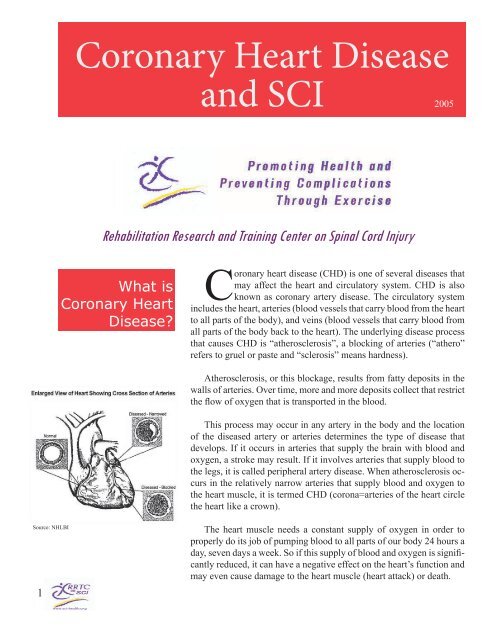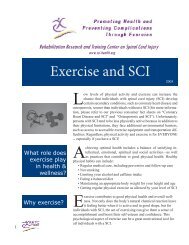Coronary Heart Disease Fact sheet - Rehabilitation Research and ...
Coronary Heart Disease Fact sheet - Rehabilitation Research and ...
Coronary Heart Disease Fact sheet - Rehabilitation Research and ...
Create successful ePaper yourself
Turn your PDF publications into a flip-book with our unique Google optimized e-Paper software.
<strong>Coronary</strong> <strong>Heart</strong> <strong>Disease</strong><br />
<strong>and</strong> SCI<br />
2005<br />
<strong>Rehabilitation</strong> <strong>Research</strong> <strong>and</strong> Training Center on Spinal Cord Injury<br />
What is<br />
<strong>Coronary</strong> <strong>Heart</strong><br />
<strong>Disease</strong><br />
<strong>Coronary</strong> heart disease (CHD) is one of several diseases that<br />
may affect the heart <strong>and</strong> circulatory system. CHD is also<br />
known as coronary artery disease. The circulatory system<br />
includes the heart, arteries (blood vessels that carry blood from the heart<br />
to all parts of the body), <strong>and</strong> veins (blood vessels that carry blood from<br />
all parts of the body back to the heart). The underlying disease process<br />
that causes CHD is “atherosclerosis”, a blocking of arteries (“athero”<br />
refers to gruel or paste <strong>and</strong> “sclerosis” means hardness).<br />
Atherosclerosis, or this blockage, results from fatty deposits in the<br />
walls of arteries. Over time, more <strong>and</strong> more deposits collect that restrict<br />
the flow of oxygen that is transported in the blood.<br />
This process may occur in any artery in the body <strong>and</strong> the location<br />
of the diseased artery or arteries determines the type of disease that<br />
develops. If it occurs in arteries that supply the brain with blood <strong>and</strong><br />
oxygen, a stroke may result. If it involves arteries that supply blood to<br />
the legs, it is called peripheral artery disease. When atherosclerosis occurs<br />
in the relatively narrow arteries that supply blood <strong>and</strong> oxygen to<br />
the heart muscle, it is termed CHD (corona=arteries of the heart circle<br />
the heart like a crown).<br />
Source: NHLBI<br />
1<br />
The heart muscle needs a constant supply of oxygen in order to<br />
properly do its job of pumping blood to all parts of our body 24 hours a<br />
day, seven days a week. So if this supply of blood <strong>and</strong> oxygen is significantly<br />
reduced, it can have a negative effect on the heart’s function <strong>and</strong><br />
may even cause damage to the heart muscle (heart attack) or death.
Am I at risk<br />
for<br />
CHD<br />
The established risk factors for developing CHD for all of the<br />
population include:<br />
•Abnormal levels of certain fats in the blood:<br />
-High levels of bad cholesterol or low density lipoprotein<br />
cholesterol (LDL-C),<br />
-Low levels of good cholesterol or high density<br />
lipoprotein cholesterol (HDL-C)<br />
•High blood pressure (hypertension)<br />
•Cigarette smoking<br />
•Lack of physical activity or exercise<br />
•Diabetes mellitus<br />
•Being overweight or obese<br />
•Older age<br />
•Family history of premature CHD<br />
What<br />
role does my<br />
SCI play<br />
Having a spinal cord injury (SCI) may increase the risk for CHD<br />
because many of the risk factors for CHD are magnified for<br />
people with a SCI:<br />
•Advanced age is a predisposing risk factor for CHD. People with<br />
SCI are now living longer after their injury <strong>and</strong> therefore have<br />
a longer period of time during which to develop atherosclerosis<br />
<strong>and</strong> CHD.<br />
•Physical inactivity is a risk factor for CHD <strong>and</strong> persons with<br />
SCI tend to have low levels of regular exercise <strong>and</strong> physical<br />
activity.<br />
•Abnormal levels of cholesterol is a risk factor for CHD <strong>and</strong><br />
many people with SCI have high levels of bad cholesterol (LDL-<br />
C) <strong>and</strong> low levels of good cholesterol (HDL-C).<br />
While having a spinal cord injury does not directly increase your risk<br />
for developing CHD, lower levels of physical activity <strong>and</strong> fitness do. To<br />
stay healthy, it has been recommended that adults engage in exercise or<br />
physical activity for 30 minutes at least 5 days of the week. Participation<br />
in regular exercise or physical activity poses unique challenges for<br />
most people with SCI. Barriers include physical limitations, access to<br />
st<strong>and</strong>ard <strong>and</strong> adapted exercise equipment, <strong>and</strong> transportation issues.<br />
Another lifestyle issue related to CHD risk is diet. Persons who eat<br />
a diet that is high in calories (at least relative to the number of calories<br />
that are used for exercise) <strong>and</strong> fat content can often be overweight or<br />
obese <strong>and</strong> have high levels of LDL-C in the blood.<br />
2
Since lack of physical activity, elevated levels of LDL-C, diabetes,<br />
<strong>and</strong> overweight/obesity are all risk factors for CHD <strong>and</strong> are sometimes<br />
more common in persons with SCI, you can see how these factors<br />
are interwoven with each other <strong>and</strong> can result in increased risk for<br />
CHD. This information should also be helpful to you in underst<strong>and</strong>ing<br />
why the <strong>Rehabilitation</strong> <strong>Research</strong> <strong>and</strong> Training Center at the National<br />
<strong>Rehabilitation</strong> Hospital is emphasizing physical activity as a means of<br />
improving the health status in persons with SCI.<br />
How do I<br />
know my risk<br />
for CHD<br />
How can I<br />
reduce my<br />
risk<br />
Risk for CHD must be calculated on an individual basis based<br />
on your own health information. If you do not have a history<br />
of CHD, there is a system called the Framingham Risk Score<br />
that can calculate your personal risk percentage for developing CHD<br />
over the next 10 years. This score incorporates your gender, age, total<br />
cholesterol, HDL-C, systolic blood pressure (the top number of your<br />
blood pressure), <strong>and</strong> whether or not you are a smoker. If you know all of<br />
this information, you can calculate your 10 year risk of having a heart<br />
attack (http://hin.nhlbi.nih.gov/atpiii/calculator.aspusertype=pub).<br />
We recommend that you speak with your personal physician about<br />
this <strong>and</strong> other possible personal issues related to CHD.<br />
Before beginning any lifestyle changes, you should always discuss<br />
the idea with you doctor. Here are some ways to improve<br />
your heart health:<br />
• Try to be physically active for 30 minutes on at least 5 days each<br />
week. This could involve several shorter sessions during the day<br />
(e.g., three 10-minute sessions) or one session of 30 minutes or more<br />
of continuous activity.<br />
• Stop smoking.<br />
• Know your blood pressure <strong>and</strong> work with your doctor to keep it<br />
below 140/90 mm Hg.<br />
• Know your bad cholesterol value (LDL-C). A value of less than<br />
130 mg/dL is recommended <strong>and</strong> less than 100 mg/dL is optimal.<br />
• Know your good cholesterol value (HDL-C). A value of less than<br />
40 mg/dL is low <strong>and</strong> 60 mg/dL or higher is good.<br />
• Eat a diet that is low in saturated fats (for example, meats <strong>and</strong> dairy<br />
products) <strong>and</strong> trans-fats (for example, certain types of margarines<br />
<strong>and</strong> oils), <strong>and</strong> high in grains, fruits, <strong>and</strong> vegetables.<br />
3<br />
• Do not eat more calories than is needed to meet your daily energy<br />
needs.
Take Home<br />
Tips<br />
1. Exercise at least 5 days every week. If you are not physically fit now,<br />
regular exercise will improve your level of fitness.<br />
2. Eating a healthy diet (www.nal.usda.gov/fnic/dga/index.html) will not<br />
only improve your heart health but will also be helpful in reducing your<br />
risk for certain other diseases (for example; diabetes <strong>and</strong> colon cancer).<br />
3. Know what your values are for blood pressure <strong>and</strong> total <strong>and</strong> LDL-C.<br />
If they are not in the recommended range for good heart health, talk with<br />
your doctor about a plan to get them into the healthy range.<br />
For more information or alternative formats, please visit our website at<br />
www.sci-health.org or call 1-866-380-4344.<br />
Disclaimer<br />
This fact <strong>sheet</strong> only provides general information. It is solely intended for informational <strong>and</strong> educational purposes<br />
<strong>and</strong> is not intended nor implied to be the diagnosis or treatment of a medical condition or a substitute for professional<br />
medical advice relative to your specific medical conditions. Always seek the advice of your physician or other<br />
qualified health provider prior to starting any new treatment or with any questions you may have regarding your<br />
medical condition.<br />
Funded by the US Dept. of Education, NIDRR,<br />
Grant #H133B031114<br />
National <strong>Rehabilitation</strong> Hospital<br />
<strong>Research</strong> Division<br />
102 Irving Street NW<br />
Washington, DC 20010-2949




